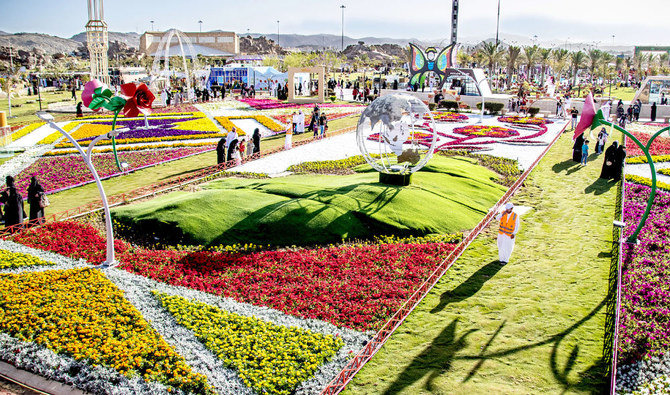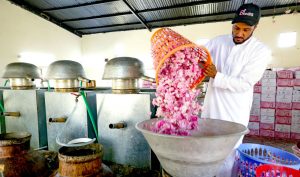
- ARAB NEWS
- 02 Jul 2025

Tareq Al-Thaqafi
MAKKAH: Farmers are readying their gear as the Taif Rose, a proud Saudi symbol, prepares for next year’s harvest amid fears of an early winter frost.
With its blush to bright pink hue, the beautiful flower is believed to be the sister of the Damascus rose. Legend has it that the seedlings were brought to the Kingdom five centuries ago after an Ottoman sultan offered Levantine rose seedlings to a nobleman in Makkah, who ordered that they were sent to Al-Hada Mountain in Taif for planting, with the area known for its mild and cool weather, similar to the climate of the Levant.
Taif is home to 2,000 rose farms. It is situated 1,900 meters above sea level, giving it an ideal atmosphere for roses to grow. The roses are planted every year at the beginning of the “Al-Tarf” season — one of the agricultural seasons that encourage the branches to bear the rose fruit.
This year, cultivation specialists warned that the upcoming winter would be a critical threat to crops, and that some farm owners are considering finding warm spray pipes to combat frost.
According to a 2018 Small and Medium Enterprises General Authority report, the Taif rose market is estimated to be worth SR52 million ($13.8 million), with a growth potential of up to SR700 million if new opportunities are adequately exploited.

They noted that some attempts to cultivate Taif roses in Europe and Arab countries did not succeed. European countries received experience and guidance from cultivation experts, but the roses failed to match the Kingdom’s quality due to the different atmosphere and soil.
Awad Al-Talhi, who owns a rose farm in Al-Shafa in Taif, told Arab News that the high areas of Taif are the best places for planting the roses, but this also leaves them highly exposed to frost, the first major threat to the success of the farms.
Al-Talhi added that the best method for dealing with frost waves is to use specialized tanks connected to warm spray pipes to remove frozen bushes. The warm water spray is effective at keeping first at pay, but it comes with high cost.
“Rose farmers begin the process of pruning trees at the beginning of every year, which takes about two-and-a-half months, depending on the size of the farm. There is no watering of the trees in this period. By mid-March, the harvest season of Taif roses begins,” said Al-Talhi.
Al-Talhi added that regular watering begins every five days until April with the end of pruning of rose bushes.
Roses are susceptible to several diseases and insect pests. They may survive without a basic pest control program, but they may not be very attractive. A pest control program starts with proper site selection, soil preparation, drainage, proper spacing, cultivar selection, and plant maintenance. These factors foster healthy roses that are better able to withstand the pressure of disease and insects.
Taif roses were first documented by Swiss traveler Johann Ludwig Burckhardt, who visited Taif in 1814. Maurice Tamiser, the French chief medical officer in the French armies, mentioned them in 1834 when he was sent to the Hejaz by Mohammed Ali. Other early Taif rose observers include French diplomat Leon Roches in 1841, and Swiss writer Charles Didier in 1854, and other travelers.
Al-Talhi said that exporting the roses abroad was unsuccessful, either as flowers or oils, due to the soil and weather in Taif that produces its unique atmosphere throughout the year.
“Foreign delegations visit Taif from time to time and carry out agricultural studies and take with them agricultural seedlings to their countries, but they have not succeeded in obtaining the same quality. They may achieve success in the first year, but the quality of the crop is not as good as the quality in Taif,” he said.
“Historically, there were many attempts to plant this type of rose in other regions and countries through pilgrims who were fascinated by the scent of this rose. It was cultivated in other areas, but it was not as good as the smell of the Taif rose,” said Khaled Al-Omari, a member of the Cooperative Committee for the Taif Rose.
“With time, and after attempts to study the quality of the Taif rose planted in the Taif heights, it was proven that the Taif soil over the centuries was the appropriate environment for cultivating it,” he added.
Al-Omari told Arab News that the Taif rose cannot be exported due to its sensitivity. But its perfume can be shipped abroad due to the ancient distillation method that preserves the quality of its fragrance.
“The people who are experienced and proficient in the distillation of the roses can successfully preserve the quality of the perfume, it’s a difficult and delicate process. There’s something in the water and soil: Taif roses planted in different areas come out different, they are not of the same quality and smell,” said Al-Omari.
Al-Omari added that the rare Taif rose has led to many historians offering different takes on its origin and the date of its appearance in Taif.
Women in the past used the rose as a colorful decoration and a scent that they placed between the folds of their clothes.
“Owners of rose factories used special pots that they brought from India. The first perfume produced by the owners of the old factories was sent to the pilgrims’ doctor. After that, it became famous and became the fragrance of kings, princes, and people of high positions.”
The rose shot to fame after its association with royalty and elite society. It still attracts global demand due to its rarity and quality. With distillation being conducted by just a few families who have passed down the skill over the generations, output is limited to major international companies that specialize in the perfume industry.